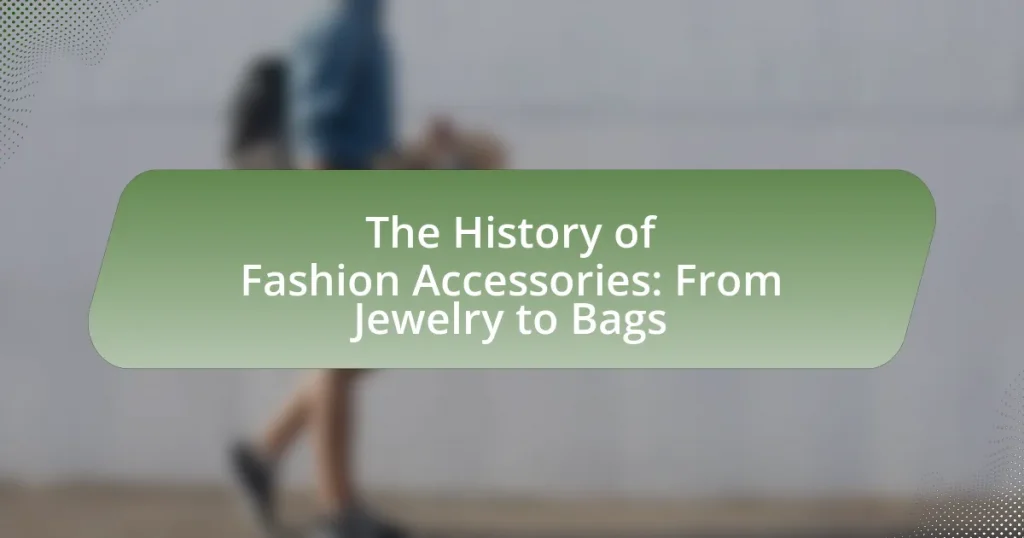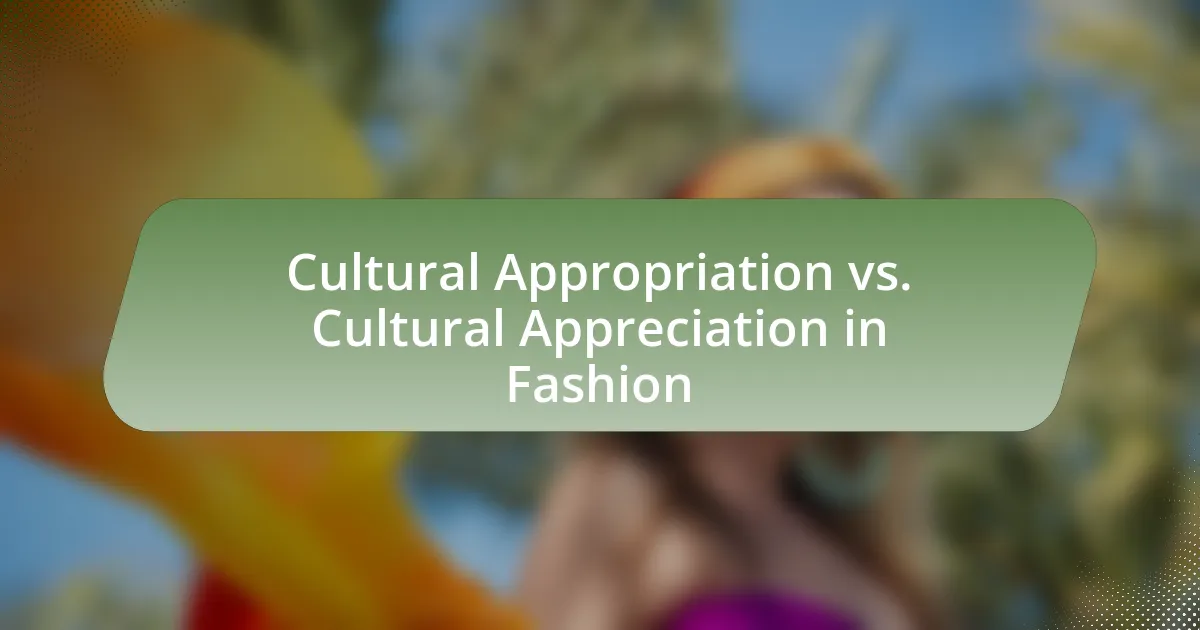Fashion accessories, including jewelry, bags, belts, hats, and scarves, have played a significant role in personal expression and cultural identity throughout history. This article explores the evolution of fashion accessories, highlighting their historical significance, the impact of cultural influences, and their transformation from functional items to essential components of style. It examines the earliest forms of accessories, the effects of technological advancements, and contemporary trends such as sustainability and personalization. Additionally, the article discusses how accessories reflect societal changes and offers tips for selecting the right pieces to enhance personal style.
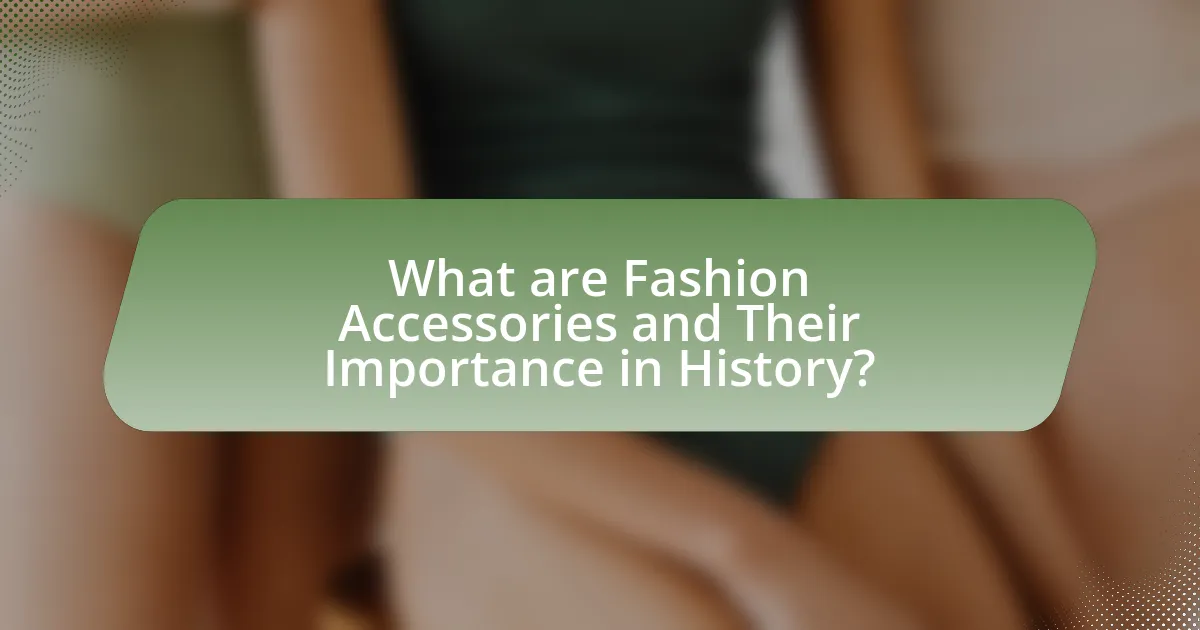
What are Fashion Accessories and Their Importance in History?
Fashion accessories are items that complement and enhance an individual’s outfit, including jewelry, bags, belts, hats, and scarves. Historically, these accessories have played a significant role in expressing social status, cultural identity, and personal style. For instance, in ancient Egypt, jewelry was not only decorative but also a symbol of wealth and power, often made from precious metals and stones. Similarly, during the Renaissance, accessories like elaborate hats and gloves indicated nobility and fashion consciousness. The evolution of fashion accessories reflects changing societal norms and technological advancements, such as the introduction of mass production in the 19th century, which made accessories more accessible to the general public. Thus, fashion accessories have been crucial in shaping personal and cultural identities throughout history.
How have fashion accessories evolved over time?
Fashion accessories have evolved significantly over time, transitioning from functional items to essential components of personal style. In ancient civilizations, accessories like jewelry served practical purposes, such as indicating social status or wealth, with materials ranging from shells to precious metals. During the Middle Ages, accessories became more ornate, with the introduction of elaborate brooches and belts that reflected the wearer’s rank and fashion trends. The Renaissance period saw a surge in creativity, leading to the use of intricate designs and gemstones in accessories.
In the 19th century, the Industrial Revolution facilitated mass production, making accessories more accessible to the general public. This era introduced items like handbags and hats, which became symbols of fashion and personal expression. The 20th century brought about further diversification, with the rise of designer brands and the influence of pop culture, leading to the creation of iconic accessories such as the Chanel handbag and Ray-Ban sunglasses.
Today, fashion accessories encompass a wide range of items, including jewelry, bags, belts, and scarves, reflecting individual style and cultural trends. The evolution of fashion accessories illustrates a shift from mere functionality to a focus on aesthetics and personal identity, influenced by historical events, technological advancements, and changing societal norms.
What were the earliest forms of fashion accessories?
The earliest forms of fashion accessories included items such as jewelry, belts, and headpieces. Archaeological findings indicate that ancient civilizations, such as the Egyptians and Mesopotamians, adorned themselves with jewelry made from materials like gold, silver, and gemstones as early as 3000 BCE. Additionally, belts were used not only for practical purposes but also as decorative elements, often embellished with intricate designs. Headpieces, including crowns and headdresses, served both aesthetic and symbolic functions, reflecting status and identity in various cultures. These accessories played a significant role in personal expression and social hierarchy throughout history.
How did cultural influences shape the development of fashion accessories?
Cultural influences significantly shaped the development of fashion accessories by dictating styles, materials, and functions based on societal values and traditions. For instance, in ancient Egypt, jewelry was not only a fashion statement but also a symbol of status and protection, often made from gold and precious stones, reflecting the civilization’s wealth and beliefs in the afterlife. Similarly, in the 18th century, European fashion saw the rise of elaborate hats and gloves, influenced by social norms and the aristocracy’s desire to display wealth and refinement. The globalization of trade further introduced diverse materials and designs, such as silk from Asia and beads from Africa, enriching the accessory landscape. These historical examples illustrate how cultural contexts have continuously informed the evolution of fashion accessories, making them a reflection of identity and societal trends.
Why are fashion accessories significant in personal expression?
Fashion accessories are significant in personal expression because they allow individuals to showcase their unique style and personality. Accessories such as jewelry, bags, and scarves serve as visual statements that can reflect cultural identity, social status, and personal taste. For instance, a study published in the Journal of Fashion Marketing and Management found that accessories play a crucial role in enhancing self-image and conveying messages about the wearer’s lifestyle choices. This demonstrates that fashion accessories are not merely decorative items; they are essential tools for personal branding and self-representation.
How do accessories complement clothing choices?
Accessories enhance clothing choices by adding visual interest, personal style, and functionality. For example, a simple dress can be transformed with the addition of statement jewelry, a stylish belt, or a fashionable handbag, creating a more complete and polished look. Historical evidence shows that accessories have been used for centuries to signify status and individuality, such as the use of brooches in the Victorian era or the popularity of handbags in the 20th century, which reflect societal trends and personal expression. Thus, accessories play a crucial role in defining and elevating overall outfits.
What role do accessories play in defining personal style?
Accessories play a crucial role in defining personal style by enhancing and personalizing an individual’s overall appearance. They serve as expressive elements that can transform a basic outfit into a unique statement, reflecting personal taste and identity. For instance, a study published in the Journal of Fashion Marketing and Management indicates that accessories significantly influence first impressions, with 70% of respondents noting that accessories can convey personality traits. This demonstrates that accessories are not merely functional but are integral to communicating style and individuality.
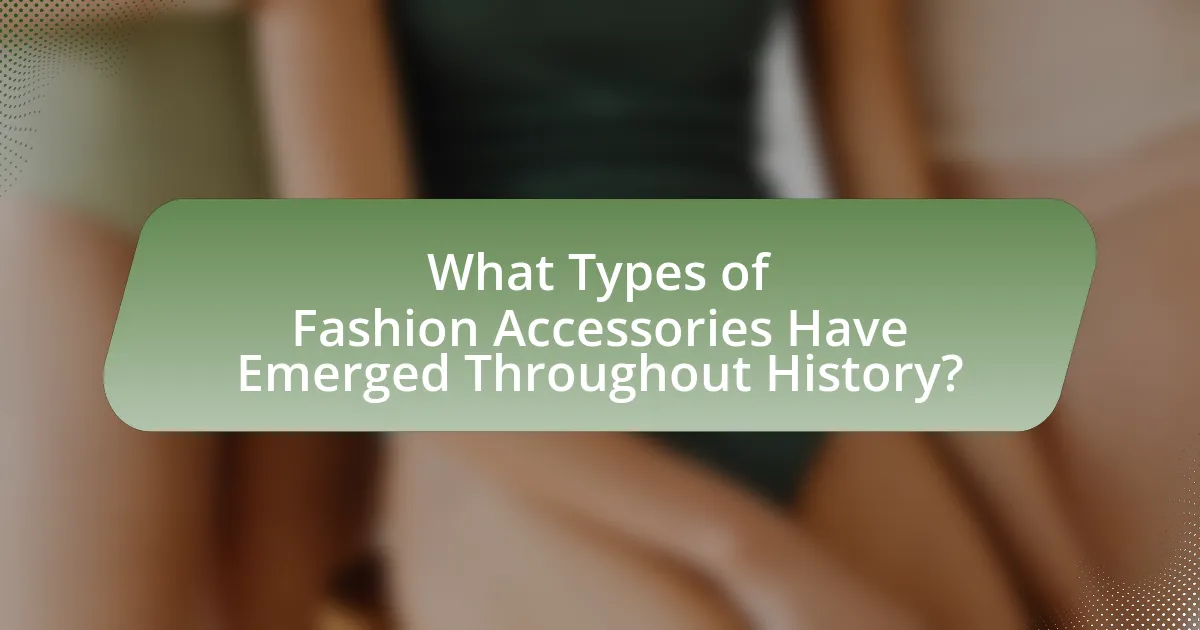
What Types of Fashion Accessories Have Emerged Throughout History?
Fashion accessories that have emerged throughout history include jewelry, hats, belts, scarves, bags, and eyewear. Jewelry dates back to ancient civilizations, with pieces made from materials like gold and gemstones serving both decorative and status-signifying purposes. Hats have evolved from practical head coverings to fashion statements, with styles like fedoras and berets gaining popularity in different eras. Belts have transitioned from functional items to decorative accessories, often used to accentuate waistlines. Scarves have been utilized for warmth and style, with silk scarves becoming iconic in the 20th century. Bags, including purses and clutches, have developed from simple pouches to essential fashion items, reflecting cultural trends and personal style. Eyewear, initially designed for vision correction, has transformed into a fashion accessory, with sunglasses becoming a staple in modern wardrobes. Each of these accessories reflects the social, cultural, and economic contexts of their times, illustrating the evolution of fashion throughout history.
What are the different categories of fashion accessories?
The different categories of fashion accessories include jewelry, bags, belts, hats, scarves, eyewear, watches, and footwear. Jewelry encompasses items like necklaces, bracelets, earrings, and rings, often used to enhance personal style. Bags serve both functional and aesthetic purposes, ranging from handbags to backpacks. Belts are used to secure clothing while also serving as a fashion statement. Hats provide protection from the elements and can complement outfits. Scarves add warmth and style, while eyewear, including sunglasses and prescription glasses, combines utility with fashion. Watches are both timekeeping devices and fashion statements, and footwear, including shoes and boots, completes an outfit while reflecting personal style. Each category plays a significant role in the overall fashion landscape, contributing to individual expression and trends.
How has jewelry evolved as a fashion accessory?
Jewelry has evolved from functional items into significant fashion accessories that reflect personal style and cultural identity. Initially, jewelry served practical purposes, such as indicating social status or providing protection, with ancient civilizations using materials like shells, stones, and metals for adornment. Over time, particularly during the Renaissance and Victorian eras, jewelry became more intricate and symbolic, showcasing craftsmanship and artistry, as seen in the use of gemstones and elaborate designs. In the 20th century, the rise of fashion designers and brands further transformed jewelry into a key element of personal expression, with trends shifting towards minimalist styles in the mid-century and bold statement pieces in the late century. Today, jewelry continues to evolve with advancements in technology and materials, including sustainable practices and innovative designs, reflecting contemporary values and aesthetics.
What are the historical trends in bags and purses?
Historical trends in bags and purses show a significant evolution influenced by social, economic, and cultural factors. In ancient civilizations, bags were primarily utilitarian, used for carrying goods, with examples like the leather pouches of the Egyptians and the woven bags of the Greeks. During the Middle Ages, bags became more decorative, often adorned with embroidery and used by both men and women, reflecting status and wealth.
The 19th century marked a turning point with the introduction of the handbag as a fashion accessory, particularly among women, as industrialization allowed for mass production. Iconic designs emerged, such as the Louis Vuitton trunk in the late 1800s, which set the standard for luxury travel bags. The 20th century saw further diversification, with the rise of designer brands and the popularity of styles like the clutch and tote, influenced by cultural movements and celebrity endorsements.
By the late 20th and early 21st centuries, bags and purses became symbols of personal identity and fashion statements, with trends shifting towards sustainability and ethical production. The emergence of brands focusing on eco-friendly materials reflects contemporary consumer values. Overall, the historical trends in bags and purses illustrate a dynamic interplay between functionality and fashion, adapting to the changing needs and desires of society.
How do accessories reflect societal changes?
Accessories reflect societal changes by serving as indicators of cultural values, economic conditions, and social norms. For instance, during the 1920s, the rise of flapper culture led to the popularity of shorter hemlines and bold accessories, symbolizing women’s liberation and changing gender roles. Similarly, the introduction of luxury handbags in the 1980s mirrored the economic boom and the increasing emphasis on status and consumerism. Historical trends in accessories, such as the shift from utilitarian designs to more expressive forms, illustrate how fashion adapts to reflect the evolving identity and aspirations of society.
What accessories became popular during specific historical periods?
During specific historical periods, various accessories gained popularity, reflecting the cultural and social dynamics of their times. In the 18th century, for example, elaborate wigs and ornate jewelry, such as brooches and necklaces, became fashionable among the aristocracy, symbolizing wealth and status. The Victorian era saw the rise of gloves and parasols, which were essential for both fashion and social etiquette. In the 1920s, flapper culture popularized accessories like cloche hats and long pearl necklaces, representing women’s liberation and a break from traditional norms. The 1980s introduced bold statement pieces, including oversized earrings and chunky bracelets, aligning with the era’s emphasis on individuality and excess. Each of these accessories not only served aesthetic purposes but also conveyed significant social messages relevant to their respective periods.
How have technological advancements influenced accessory design?
Technological advancements have significantly influenced accessory design by enabling innovative materials, production techniques, and customization options. For instance, the introduction of 3D printing technology has allowed designers to create intricate and personalized accessories that were previously impossible to manufacture. This technology facilitates rapid prototyping and reduces production costs, making unique designs more accessible to consumers. Additionally, advancements in smart technology have led to the integration of functionality into accessories, such as smartwatches and fitness trackers, which combine style with utility. The use of sustainable materials, driven by technological innovations in recycling and material science, has also transformed accessory design, aligning it with contemporary environmental concerns. These developments illustrate how technology not only enhances aesthetic appeal but also expands the functional capabilities of fashion accessories.
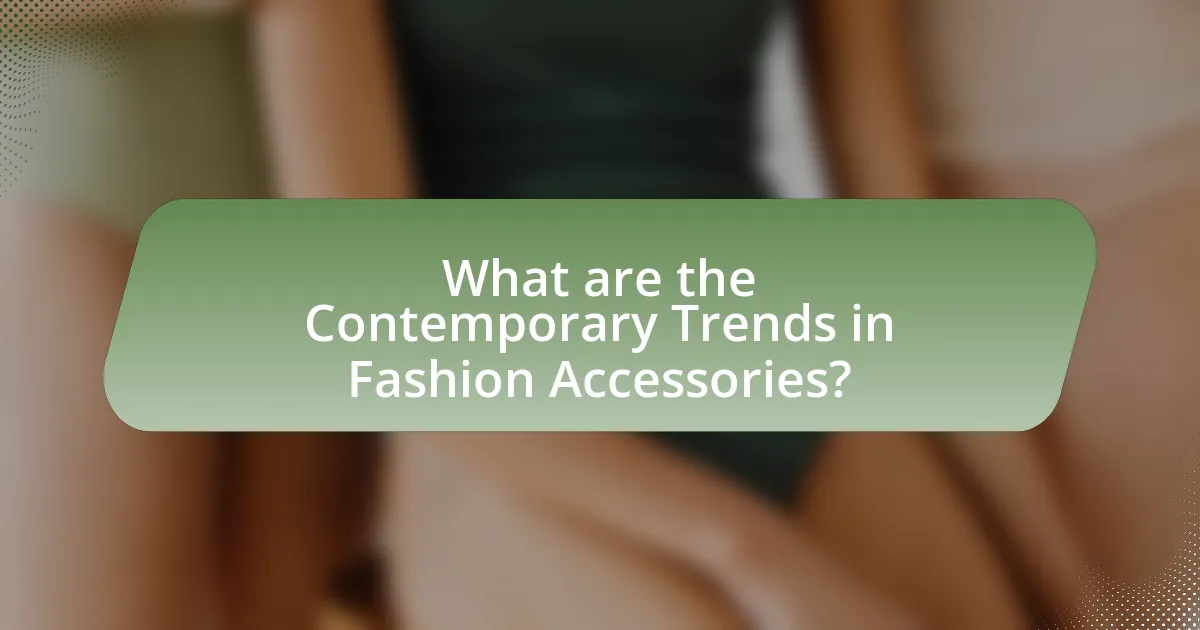
What are the Contemporary Trends in Fashion Accessories?
Contemporary trends in fashion accessories include sustainable materials, bold statement pieces, and personalization. The rise of eco-conscious consumerism has led brands to adopt sustainable practices, utilizing recycled or organic materials in their products. Additionally, oversized bags, chunky jewelry, and vibrant colors are gaining popularity, reflecting a shift towards self-expression and individuality. Personalization, such as custom engravings or unique designs, allows consumers to create accessories that resonate with their personal style. These trends are supported by market research indicating a growing demand for unique and sustainable fashion items, with the global sustainable fashion market projected to reach $8.25 billion by 2023.
How do modern fashion accessories differ from those of the past?
Modern fashion accessories differ from those of the past primarily in their design, functionality, and materials. Contemporary accessories often emphasize minimalism and versatility, reflecting current trends that prioritize practicality alongside aesthetics. For example, modern bags frequently incorporate multifunctional features, such as convertible designs that can be worn in multiple ways, unlike traditional bags that served a singular purpose. Additionally, advancements in technology have led to the integration of smart features in accessories, such as smartwatches and tech-enabled jewelry, which were not present in historical designs. Furthermore, the use of sustainable materials has gained prominence in modern fashion, contrasting with the more conventional materials used in the past, such as leather and metals. This shift towards eco-friendly options reflects a growing awareness of environmental issues in contemporary fashion.
What are the current popular materials used in accessories?
Current popular materials used in accessories include leather, metal, fabric, and sustainable materials like recycled plastics. Leather remains a staple due to its durability and classic appeal, while metal is frequently used in jewelry and hardware for its strength and aesthetic versatility. Fabric, including cotton and silk, is commonly utilized in bags and scarves for its variety and comfort. Sustainable materials, such as recycled plastics and organic textiles, are gaining traction as consumers increasingly prioritize eco-friendly options. This trend is supported by a growing market demand for sustainable fashion, with reports indicating that 66% of consumers consider sustainability when making purchases.
How do sustainability and ethical considerations impact accessory choices?
Sustainability and ethical considerations significantly influence accessory choices by driving consumer demand for environmentally friendly and socially responsible products. As awareness of environmental issues and labor practices increases, consumers are more inclined to select accessories made from sustainable materials, such as organic cotton or recycled metals, and produced under fair labor conditions. For instance, a 2021 survey by McKinsey & Company found that 67% of consumers consider sustainability when making fashion purchases, indicating a strong preference for brands that prioritize ethical practices. This shift in consumer behavior compels accessory brands to adopt sustainable practices, such as using eco-friendly materials and ensuring ethical labor standards, to remain competitive in the market.
What are the key factors influencing accessory trends today?
Key factors influencing accessory trends today include consumer preferences, technological advancements, and sustainability concerns. Consumer preferences are shaped by social media and celebrity endorsements, driving demand for specific styles and brands. Technological advancements, such as 3D printing and e-commerce, enable rapid production and distribution of accessories, allowing brands to respond quickly to trends. Sustainability concerns are increasingly important, with consumers favoring eco-friendly materials and ethical production practices, influencing brands to adopt sustainable practices. These factors collectively shape the dynamic landscape of accessory trends in the fashion industry.
How do social media and influencers shape accessory popularity?
Social media and influencers significantly shape accessory popularity by creating trends and driving consumer engagement. Platforms like Instagram and TikTok allow influencers to showcase accessories in visually appealing ways, leading to increased visibility and desirability. For instance, a study by the American Marketing Association found that 49% of consumers rely on influencer recommendations for their purchasing decisions, highlighting the impact of social media on consumer behavior. Additionally, viral challenges and hashtag campaigns can rapidly elevate specific accessories, making them must-have items within a short timeframe. This dynamic interaction between influencers and their followers fosters a culture of aspiration and immediacy, directly influencing accessory trends.
What role do fashion shows play in setting accessory trends?
Fashion shows play a crucial role in setting accessory trends by showcasing new designs and styles that influence consumer preferences and retail offerings. Designers present their collections during these events, often highlighting innovative accessories that capture the attention of fashion editors, influencers, and buyers. This exposure leads to increased visibility and desirability for specific items, as seen in the rise of statement bags and bold jewelry pieces that frequently debut on runways. Historical examples include the 2010 Chanel show, where oversized handbags became a trend, demonstrating how runway presentations can directly impact market trends and consumer behavior.
What Tips Can Help You Choose the Right Fashion Accessories?
To choose the right fashion accessories, consider your personal style, the occasion, and how the accessories complement your outfit. Personal style influences the types of accessories that resonate with you, whether it’s minimalist, bohemian, or classic. The occasion dictates the formality and appropriateness of the accessories; for example, elegant jewelry suits formal events, while casual pieces work for everyday wear. Additionally, accessories should enhance your outfit without overwhelming it; for instance, a statement necklace can elevate a simple dress, while too many bold pieces can create visual clutter.
How can you select accessories that enhance your outfit?
To select accessories that enhance your outfit, focus on color coordination, balance, and personal style. Color coordination involves choosing accessories that complement or contrast with your outfit’s colors, creating a cohesive look. Balance refers to the proportion of accessories to your outfit; for example, if wearing a statement piece, keep other accessories minimal. Personal style is crucial; select accessories that reflect your individuality and comfort. Research indicates that well-chosen accessories can elevate an outfit significantly, as they add depth and interest, making the overall appearance more polished and intentional.
What are some common mistakes to avoid when accessorizing?
Common mistakes to avoid when accessorizing include over-accessorizing, mismatching styles, and neglecting proportions. Over-accessorizing can overwhelm an outfit, making it look cluttered; for example, wearing multiple statement pieces can detract from the overall look. Mismatching styles, such as pairing casual accessories with formal attire, can create a disjointed appearance. Additionally, neglecting proportions, like wearing oversized accessories with a petite frame, can lead to an unbalanced look. These mistakes can diminish the intended impact of accessories, highlighting the importance of thoughtful selection and coordination.
